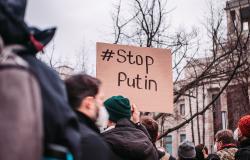Arming Ukraine: Weapons Control and the Future of International Order

Anna Stavrianakis explores how international arms transfer rules apply to the war in Ukraine and assesses the implications for international order.
The war in Ukraine has generated mounting attention to the questions of arms exports and military aid. In this, the key international instrument for thinking about how to regulate arms exports is the Arms Trade Treaty, which sets common international standards for the transfer of weapons. The war in Ukraine is a clear case of self-defence against territorial aggression, against an invasion marked by violations of international humanitarian law (IHL) in the form of targeting of civilians and widespread gender-based violence of various kinds. In general terms, then, it is clearly possible to argue that arms transfers to Ukraine would “contribute to” rather than “undermine” peace and security under the terms of the ATT because they allow for the self-defence of Ukraine and enable its military to fight, which is a prerequisite for peace. If the Ukrainians can’t fight, there is occupation, which is neither peace nor security.
Beyond this general position, there are also – inevitably – risks associated with sending weapons into a war zone. These risks include that weapons are misused by Ukrainian forces in their own violations of IHL against Russian soldiers or civilians, or indeed segments of the Ukrainian population. Or that weapons are diverted from their intended end-user, be it the capture of high-tech weapons systems by Russian forces, or the spread of small arms and light weapons throughout the population as a result of efforts to conscript and arm the adult male population and the influx of foreign fighters. There is also a potential risk of diversion as a result of corruption within the Ukrainian military, which has been a long-standing issue.
Such risks are precisely what the ATT is supposed to address. Under Article 7, for example, state parties must not authorise transfers if there is an “overriding risk” that the weapons could be used to commit or facilitate a serious violation of international human rights or humanitarian law – including gender-based violence – terrorism or transnational organized crime. And under Article 11, states are obliged to take measures to prevent the diversion of weapons. It is incumbent on states parties to have a clear, well understood process for assessing these risks. But we know from other high-profile cases – such as arms sales to the Saudi- and UAE-led coalition and the war in Yemen – that this isn’t always the case, as in the UK, USA and France, or that these risks have been slow to be understood, as in the case of European exporting states who belatedly restricted some arms transfers. We also know that Ukraine has been receiving US-led military assistance since 2014 that has been effective because it focused on core military tasks and not simply the transfer of expensive shiny high-tech kit. But we also know Ukraine is now the largest single recipient of US security assistance – receiving in 2022 as much US assistance as Afghanistan, Israel and Egypt in 2020 combined – and that vetting and monitoring efforts to prevent or address diversion have been weak, both in the Ukraine case and in other countries. And the USA is not a state party to the ATT; it became a signatory in 2013 and in 2019 Donald Trump withdrew the US signature; President Biden has not moved to reinstate it, but the USA remains on the list of Signatories.
These risks should alert us to two of the unspoken political dimensions of arms controls. First, there are existing rules and embargoes that have not been properly implemented or that states have resisted strengthening. For example, in terms of preventing Russian military build-up, there has been an EU arms embargo on Russia in place since 2014, but UK and European companies have been exporting components classified as “dual use” to Russia that they’ve used to build military systems. On dual use controls, there has been resistance to proactive due diligence in comparison to other areas such as the environment, again signalling the special treatment that the arms trade all often receives. Earlier this year, the UK belatedly passed legislation to ban the export of dual use items to Russia: this makes Prime Minister Johnson and the UK look like a tough arms controller at a time that is politically expedient but ignores the fact that there has been an arms embargo on Russia since 2014 and that efforts to tighten and properly implement dual use controls have up till now been marginalised.
The second issue is the prospect of militarisation as part of the response to Russian aggression. The Ukraine war alerts us to the perennial question of how to make judgments about what constitutes a “legitimate” defence need or a “defensive” weapon. These are always matters of interpretation: but we know from the history and politics of the arms trade that those interpretations are shaped by the interests of war-mongers. So on the one hand, some Ukrainian feminists who organise to support victims of domestic violence – that itself in part results from militarisation - have been vocal about the need for more weapons to support national self-defence so they can stay alive. That tells us that not all war preparation is equally militarising. On the other hand, some state leaders are using the war as an opportunity to further militarise. Across NATO, states have announced increases in defence spending; and the European Peace Facility has announced 2bn Euros to support EU member states supplying Ukraine. Purported plans for eastern European EU member states to supply Russian-designed MiGs and Sukhois to Ukraine and have their inventories backfilled with US-made F-16s may have stalled, but the war is widely being noted as an opportunity for the expansion of western arms markets. There is a line to tread between supporting self-defence and using a crisis as an opportunity for militarisation, proliferation and profit-making.
Off the back of these issues, there are two lessons that the war in Ukraine may hold for the future of the ATT and international order. First, that the treaty is what states make of it. We know that the ATT text, like any regulatory instrument, is the product of negotiation and has ambiguity built in to its formulations. So what matters is implementation: how states interpret the treaty and are seen to interpret and implement it by domestic constituencies and other states. And in that respect we also have to think about the implementation of the ATT in relation to other cases, which takes us to the second lesson. The ATT is supposed to symbolise a rules-based international system. Russia, through its invasion of Ukraine, is clearly undermining that system. But the response from other states is also part of that system: this is why it is crucial that ATT states parties themselves adhere to, and are seen to adhere to, the rules based international system. That is why it matters that western states have been arming the Saudi- and UAE-led coalition for the past seven years in violation of the ATT, and why it is important that we talk not just about the case of Ukraine itself but also the wider ATT regime and its operation. States arming the Saudi- and UAE-led coalition have little legitimacy to try and defend a rules-based international system. All State Parties to the ATT must put their own house in order if they are to be party to international housekeeping.
Anna Stavrianakis is Professor of International Relations at the University of Sussex, UK, where she researches and teaches on the arms trade, arms control, militarism and global (in)securities.0
Photo by Matti


